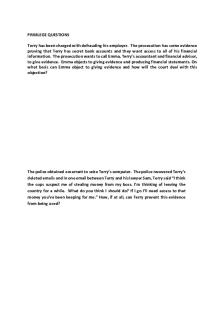Z-test Questions PDF

| Title | Z-test Questions |
|---|---|
| Author | Ashley Athy |
| Course | Data Analysis With Spss |
| Institution | Southern Illinois University Edwardsville |
| Pages | 1 |
| File Size | 53.5 KB |
| File Type | |
| Total Downloads | 19 |
| Total Views | 142 |
Summary
Z-Test questions and answers...
Description
Homework Assignment #2: z-test (Chapter 8 in G & W) Answer the following questions in sentence form 1. In the z-test formula… a. Explain what is measured by X´ -µ b. Explain what is measured by the standard error ( σ M ¿ 2. In words, define the term “Alpha level” and explain what a critical region is in a hypothesis test. 3. If the alpha level is changed from .05 to .01… a. What happens to the boundaries for the critical region? b. What happens to the probability of a Type I error?
For the following, compute the answers needed, showing all work and answering questions in a sentence when appropriate. 4. Although there is a popular belief that herbal remedies such as Ginkgo balboa and Ginseng may improve learning and memory in healthy adults, these effects are usually not supported by well-controlled research. In a typical study, a researcher obtains a sample of n = 36 participants and has each person take the herbal supplements every day for 90 days. At the end of the 90 days, each person takes a standardized memory test. Higher scores indicate better memory. For the general population, the test scores are normally distributed with µ = 80 and σ = 18. In your study, you found your sample of participants had an average of X´ = 84. Is this a big enough effect to conclude that the difference was due to the supplements? Follow the steps below to find out… a. State your null hypothesis using symbols b. State your alternative hypothesis using symbols c. Assuming a two-tailed test and α = .05, indicate the critical value of Z needed to reject the null hypothesis. d. Compute a z-test e. Decide to accept or reject the null hypothesis f. State what this decision means for the interpretation of the experiment- did the supplement improve memory? 5. Repeat steps d, e, and f again, but this time use σ = 12 (use the rest of the values listed in 4). What did finding a smaller standard deviation do to our conclusion? 6. Repeat steps d, e, and f again, but this time use X´ = 88 (use the rest of the values listed in 4). What did finding a larger effect of the supplement do to our conclusion? 7. Repeat steps d, e, and f again, but this time use n = 80 (use the rest of the values listed in 4). What did using a larger sample size have on our conclusion?...
Similar Free PDFs

Questions
- 10 Pages

Questions
- 88 Pages

Questions
- 1 Pages

Questions
- 46 Pages

Exam, questions
- 1 Pages

Sample Questions
- 3 Pages

Privilege Questions
- 1 Pages

Integration questions
- 7 Pages

Apple Questions
- 1 Pages

Defects Questions
- 2 Pages

Sephora questions
- 4 Pages

Viva questions
- 6 Pages
Popular Institutions
- Tinajero National High School - Annex
- Politeknik Caltex Riau
- Yokohama City University
- SGT University
- University of Al-Qadisiyah
- Divine Word College of Vigan
- Techniek College Rotterdam
- Universidade de Santiago
- Universiti Teknologi MARA Cawangan Johor Kampus Pasir Gudang
- Poltekkes Kemenkes Yogyakarta
- Baguio City National High School
- Colegio san marcos
- preparatoria uno
- Centro de Bachillerato Tecnológico Industrial y de Servicios No. 107
- Dalian Maritime University
- Quang Trung Secondary School
- Colegio Tecnológico en Informática
- Corporación Regional de Educación Superior
- Grupo CEDVA
- Dar Al Uloom University
- Centro de Estudios Preuniversitarios de la Universidad Nacional de Ingeniería
- 上智大学
- Aakash International School, Nuna Majara
- San Felipe Neri Catholic School
- Kang Chiao International School - New Taipei City
- Misamis Occidental National High School
- Institución Educativa Escuela Normal Juan Ladrilleros
- Kolehiyo ng Pantukan
- Batanes State College
- Instituto Continental
- Sekolah Menengah Kejuruan Kesehatan Kaltara (Tarakan)
- Colegio de La Inmaculada Concepcion - Cebu



